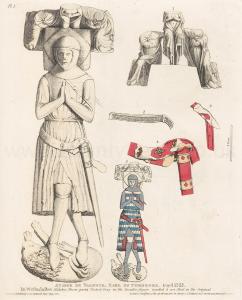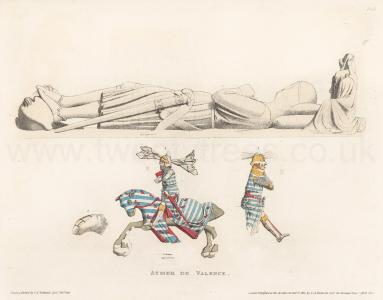Effigy of Aymer de Valence, Earl of Pembroke
Effigy of Aymer de Valence, Earl of Pembroke is in Monumental Effigies of Great Britain.
AYMER DE VALENCE was the third and youngest son of William de Valence, whose effigy has already been described, and by the death of his brothers during his father's life-time, succeeded him in the Earldom of Pembroke. He was much employed in military service by his kinsman Edward I. particularly in his Scottish wars. That King going into France in 1286 left him Regent of the Realm. In 1305 he was appointed Keeper of the Marches of Scotland about Berwick, and Commander of the Forces sent to oppose Robert Bruce, Earl of Carrick. He was present with King Edward at the time of his death at Burgh upon the Sands [Note. Burgh by Sands, Cumberland is in Cumberland being on the west coast] in Northumberland, who requested him to protect his son from the contamination of the debauched foreigner Gavaston. He united with the Barons against that minion of the second Edward, besieged and took him prisoner in Scarborough Castle [Map]. According to the capitulation Gavaston was to have been allowed to have an interview with the King, and to be tried by his Peers; but the Earl of Warwick took the profligate Gascon from de Valence's custody, and summarily beheaded him on Blacklow Hill, near Warwick. In 1314 the Earl of Pembroke was present at the battle of Bannockburn, so disastrous to the English arms in Scotland. He is said to have met his death in France at a tournament, which was appointed by himself in order to celebrate his marriage with his third wife Mary (age 22), daughter of Guy de Chastillon, Earl of St. Pol. She founded Pembroke Hall, in the University of Cambridge. Aymer de Valence was buried on the North side of the Choir of the Abbey Church at Westminster [Map], and his tomb is celebrated for its architecture and sculptural decorations. In the trefoil ornament which fills up the pediment on either side the monument he is represented on his barded horse. The compartments round the altar slab, on which his effigy reposes, are occupied by elegant statues representing his friends and connexions, and decorated with escutcheons of their arms.


Details. Plate 1. 1. Figures at the head of the Effigy. 2. Band or lace of the hood. 3. Band confining thesurcoat to the waist. 4. Sword belt. Effigy as originally painted: Plate If. 1. Toe of the solerette of the figure on horseback. Figure on horseback, North side of the tomb; basnet, aventaille, mantelet, surcoat, &c. Bases of the barded horse, bearing the bars and martlets of De Valence. 3. Figure on the North side of the tomb.

